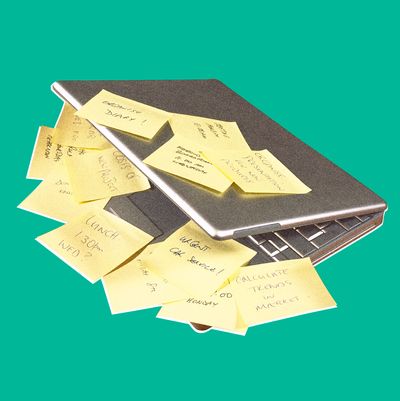
If you jot down a reminder on a Post-it, and then forget to put the post-it someplace visible, and then your deadline comes and goes and you never even see the reminder — did it ever really happen?
For all intents and purposes, no, not really. A reminder, after all, only deserves the label if it actually reminds; otherwise, it’s just some words on a piece of paper. But a new study in the journal Psychological Science makes the case for a better, less intuitive way to leave yourself reminders: a trick called the “reminders by association” approach, which pairs up random objects and images with items on your to-do list. Rather than remembering the thing you have to do, the study authors argued, just remember that you’ve imbued a mug or a ball or what have you with special significance; when you see the object later on, the rest will come back to you.
In the first part of the study, the authors inserted an extra step at the beginning of an unrelated online survey, asking participants if they wanted a dollar donated to charity on their behalf. To signify that they wanted the donation, all they had to do was pick up a paper clip from a pile near the door on the way out. The subjects were then asked if they intended to go through with the donation; if they said yes, they clicked through to one of two screens: either a simple “thank you” or a message telling them that an elephant statue had been placed near the door as a reminder to grab the paper clip.
A little convoluted, but the underlying question was a fairly simple one: Could a randomly assigned, seemingly arbitrary reminder be an effective one? The results suggested that it could — 72 percent of the people who saw the message about the elephant statue remembered to pick up the paper clip, compared to 42 percent of those who saw the shorter message. In another experiment, volunteers were given coupons to a coffee shop, and some were told there’d be a toy at the counter to remind them to use the coupon; even though there was no inherent connection between the toy and the coupon, people who had been told to look out for it later remembered to use their coupons much more frequently than those who had no such cue.
Past research has suggested that the ideal reminder has a few things going for it. First is attention-grabbing status — if it blends in too well to the surroundings, like a pen on a desk, you run the risk of overlooking it, something less likely to happen with, say, the elephant statue. And second is timing — specifically, just the right amount of time between when you see the reminder and when you need to do whatever it’s telling you. “They must be delivered at precisely the relevant future moment when a previously formed intention can be enacted,” the study authors wrote. “Arriving even a few minutes before action is possible can render reminders ineffective.”
The problem with this particular strategy, though: It takes some cognitive effort to make the necessary associations in the first place. Setting an alarm for a meeting is a one-and-done thing; building the mental bridge between a countertop toy and that coupon in your wallet requires you to keep that connection in your brain indefinitely.
For this reason, the study authors suggest, the trick may be the best choice for situations where things like Post-its and alarms won’t fit, like events with no set date. “The reminders-through-association approach is also well suited for remembering to opportunistically perform a behavior when follow-through can occur only at an unknown future time,” they wrote. “For example, you might want to remember to buy diapers the next time you happen to be in CVS, or to ask a friend about how a medical appointment went the next time he or she calls.” Maybe put a bobby pin in your wallet next to your credit card, to see the next time you go to pay at a drugstore, or put a sticker on your phone as a prompt for when you talk to your friend. Whatever the reminder object is, choose it carefully; otherwise, it’s just one more thing to forget.




